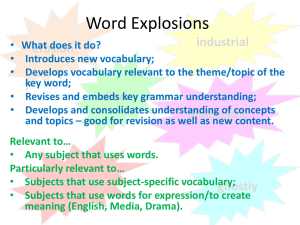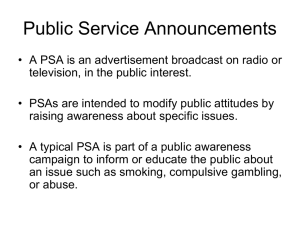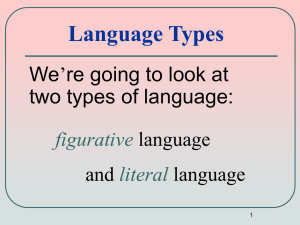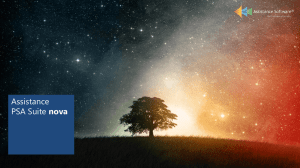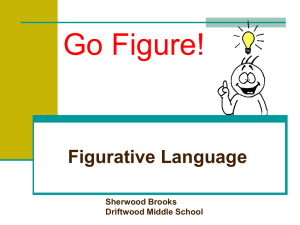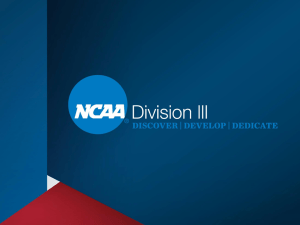Figures of Speech & Hebrew Poetry
advertisement
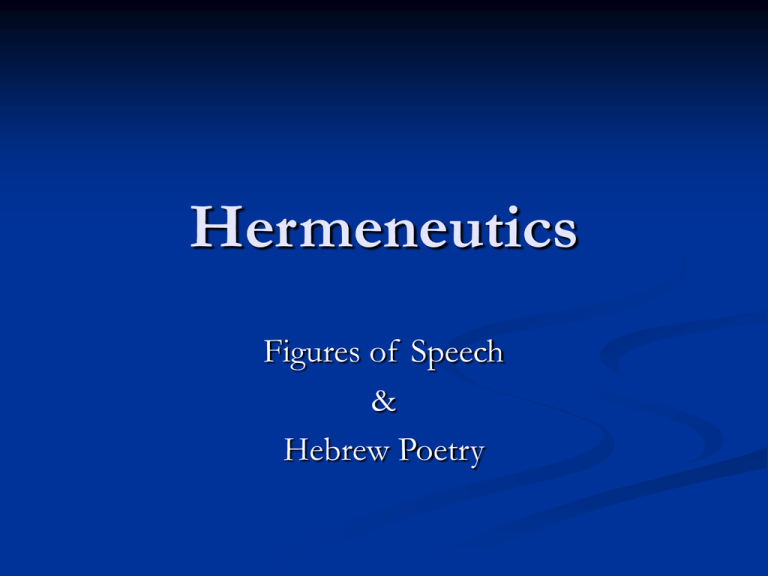
Hermeneutics Figures of Speech & Hebrew Poetry What Is a Figure of Speech? “The laws of grammar describe how words normally function. In some cases, however, the speaker or writer purposely sets aside those laws to use new forms, forms we call figures of speech” (Zuck, p. 143). “A figure is simply a word or a sentence thrown into a peculiar form, different from its original or simplest meaning or use” (Bullinger, as cited in Zuck, p. 143). There are thousands of figures of speech in the Bible. They serve to express truth in vivid and interesting ways. Why Figures of Speech Are Used To add color or vividness. To arrest attention. “You are like whitewashed tombs” (Matt 23:27). To summarize a concept. “You yourselves have seen what I did to the Egyptians, and how I bore you on eagles’ wings, and brought you to Myself ” (Exod 19:4). To make a truth easier to remember. “Beware of the dogs” (Phil 3:2). To make abstract ideas more concrete. “The Lord is my rock” (Psa 18:2). “The Lord is my shepherd” (Psa 23:1). To encourage reflection. “And he will be like a tree firmly planted by streams of water” (Psa 1:3). How Do You Know If an Expression Is Figurative or Literal? The short answer: context! “Generally an expression is figurative when it is out of character with the subject discussed, or contrary to fact, experience or observation” (Zuck, p. 145). Guidelines Assume literal communication unless there is good reason for taking it otherwise. A figurative sense is intended if the literal would involve an impossibility or absurdity. Note whether a figurative expression is followed by an explanatory literal statement (i.e. “those who are asleep” in 1 Thess 4). Note qualifying adjectives (“sword of the Spirit,” “a living stone”). Does Figurative Language Oppose Literal Interpretation? No! Figures of speech are part of language, and convey literal truth. They do not oppose literal interpretation, but are part of it. Zuck uses the terms ordinary-literal and figurativeliteral. There is a distinction between figures of speech and figurative (or allegorical or mystical) interpretation. Figures of Speech Involving Comparison “You are the salt of the earth” (Matt 5:13). “Dogs have surrounded me” (Psa 22:16) Metaphor - a comparison between things in which one thing is, acts like, or represents another. Hypocatastasis – a comparison in which the likeness is implied by a direct naming. “They are like chaff which the wind drives away” (Psa 1:4). Simile – a comparison in which one thing explicitly (by using like or as) resembles another. Figures of Speech Involving Substitution “Let us strike at him with our tongue” (Jer 18:18). Prisca and Aquila “risked their own necks” for the apostle Paul (Rom 16:4). Synechdoche – the substitution of the part for the whole or the whole for the part. “Thou dost know when I sit down and when I rise up” (Psa 139:2 Metonymy – the substitution of one word for another. Merism – a form of synechdoche in which the totality of whole is substituted by two contrasting or opposite parts. “To occupy this ministry and apostleship from which Judas turned aside to go to his own place” (Acts 1:25). Hendiadys – (“one through two”) substitution of two coordinate terms for a single concept in which one of the elements defines the other. Figures of Speech Involving Substitution “The mountains and the hills will break forth into shouts of joy before you, And all the trees of the field will clap their hands” (Isa 55:12). “For the eyes of the LORD move to and fro throughout the earth that He may strongly support those whose heart is completely His” (2 Chronicles 16:9). Personification – ascribing human characteristics or actions to inanimate objects or ideas or to animals. Anthropomorphism – ascribing human characteristics or actions to God. There are also anthropopathisms and zoomorphisms in Scripture. “Listen, O earth and all it contains” (Mic 1:2) Apostrophe – direct address to an object as if it were a person, or to an absent or imaginary person as if he were present. Figures of Speech Involving Omission or Suppression “He appeared to Cephas, then to the twelve” (1 Cor 15:5). Ellipsis – an omission of a word or words that must be supplied to complete the sentence grammatically. “Is anything too difficult for the LORD?” (Gen 18:14) Rhetorical question – a question which does not require a verbal response and is given to force the reader to answer in his mind and to consider the implications of the answer. Figures of Speech Involving Understatement or Overstatement “Every night I make my bed swim, I dissolve my couch with my tears” (Psa 6:6). “But Paul said, ‘I am a Jew of Tarsus in Cilicia, a citizen of no insignificant city; and I beg you, allow me to speak to the people’” (Acts 21:39). Litotes – an understatement or a negative statement to express an affirmation. “But when David returned to bless his household, Michal the daughter of Saul came out to meet David and said, ‘How the king of Israel distinguished himself today!’”(2 Sam 6:20). Hyperbole – a deliberate exaggeration, in which more is said than is literally meant, in order to add emphasis. Irony – a kind of ridicule expressed indirectly in the form of a compliment. “I have heard of Thee by the hearing of the ear” (Job 42:5). Pleonasm – a repetition of words or the adding of similar words, which in English seems redundant. Figures of Speech Involving Inconsistency “I urge you therefore, brethren, by the mercies of God, to present your bodies a living and holy sacrifice” (Rom 12:1) Oxymoron – a combining together of terms that are opposite or contradictory. “For whoever wishes to save his life shall lose it; but whoever loses his life for My sake and the gospel’s shall save it” (Mark 8:35). Paradox – a statement that is seemingly absurd or contradictory to normal opinion. Guidelines for Interpreting Figures of Speech Determine if a figure of speech is involved. Determine the figure and the referent. Determine the points of comparison between the figure and the referent. Do not assume that a figure always means the same thing; context will determine the meaning in each case. Do not press a figure beyond its intended meaning (“I come like a thief ”). Hebrew Poetry It has been estimated that nearly half of the OT has been written in Hebrew poetry. Its distinguishing characteristic is not syllables per line or rhyme, but parallelism. Different types of parallelism include: Synonymous Antithetic Synthetic Examples of Parallelism “Righteousness exalts a nation, But sin is a disgrace to any people” (Prov 14:34). Antithetic (simple) “An ox knows its owner, And a donkey its master’s manger, But Israel does not know, My people do not understand” (Isa 1:3) Antithetic (compound) Examples of Parallelism If you have been snared with the words of your mouth, Have been caught with the words of your mouth (Prov 6:2) Identical They did not keep the covenant of God, And in His law they refused to walk (Psa 78:10) Inverted Examples of Parallelism How blessed is the man who does not walk in the counsel of the wicked, Nor stand in the path of sinners, Nor sit in the seat of scoffers! But his delight is in the law of the LORD, And in His law he meditates day and night. Synthetic (Cumulative) - consists of a climax of thought running through the successive parallels. Relationship Between Figures of Speech extended Simile Parable Metaphor Allegory extended Next Week: Types and Symbols Additional Assignment Go to the Berachah website (www.berachahbiblechurch.org), to the “Institute” tab, then to “BBI Schedule.” Go to the discussion forum for Hermeneutics Login: users Password: blessing Establish a sign-in and password for yourself. Post a response to the question there between now and next Friday, October 20.
